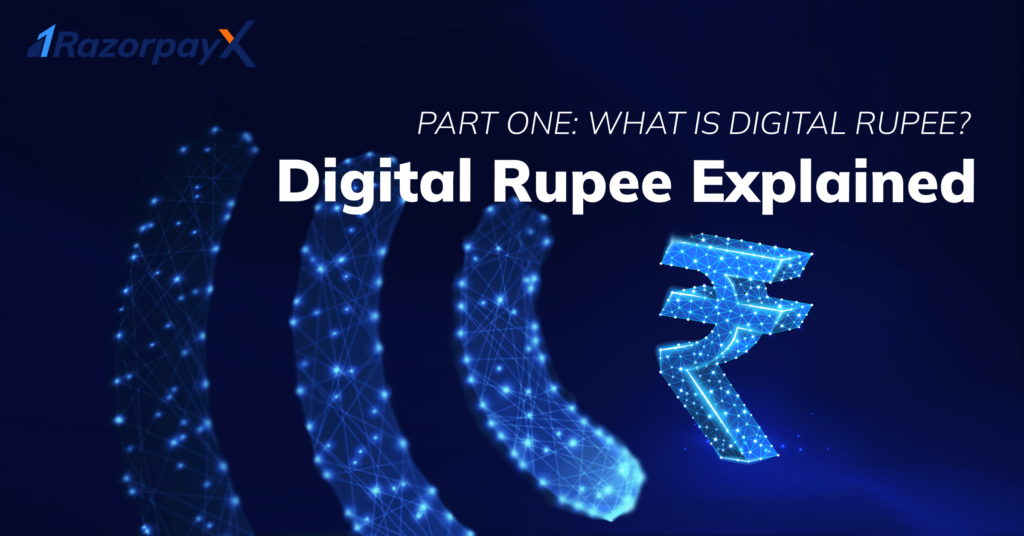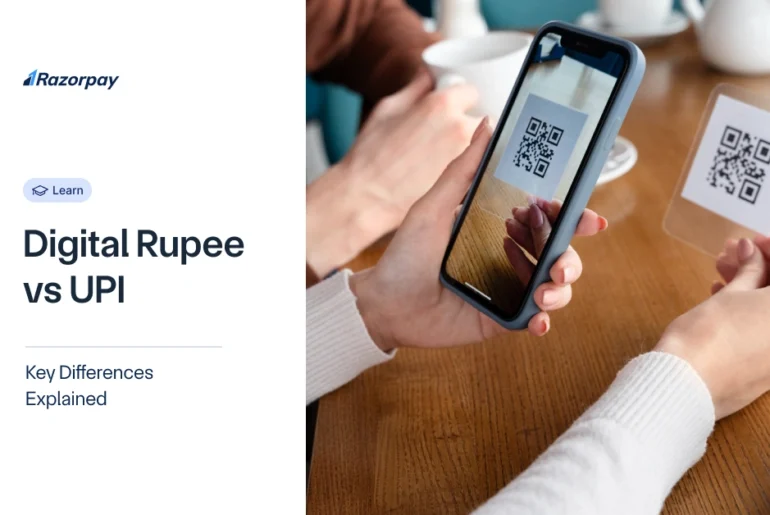Table of Contents
The new pilot launched by RBI: What is Digital Rupee?
Money has gone through progressive evolution from commodity to metallic currency to paper currency to digital currency, the impact of which has been prominent in the monetary landscape of India.
RBI and the Indian government have been very supportive of digital payments – with the launch of BHIM, UPI, and the implementation of these digital payment gateway platforms in practically every single retail space.
And today, we meet the digital token of the nation as acknowledged by RBI.
The Digital Rupee or CBDC is the RBI’s newest foray into a digital form of physical note currency. It was issued by the Reserve Bank of India on November 1st 2022. The electronic form of this currency has the potential to pave the way to a cashless economy.
Okay, so what is CBDC?
Central Bank Digital Currency (CBDC) as defined by RBI is the digital form of legal tender. To put it simply-
| CBDC is sovereign currency issued and regulated by the Central Banks in alignment with their financial policy. |
This is the digital form of physical currency which is designed to further reduce dependency on the note currency. It is easily convertible against commercial bank money and cash.
Read More: Concept Note on CBDC
What was the motivation behind the launch of Digital Rupee?
The rapid burgeoning of cryptocurrencies lately has been a challenge to the financial stability of the country. RBI has highlighted multiple times about the negative consequences of these digital assets on the macroeconomic stability of the country.
According to RBI Reports, the total expenditure estimated on security printing during April 1, 2021 to March 31, 2022 was ₹4,984.80 crore as against ₹4,012.10 crore in the previous year (July 1, 2020 to March 31, 2021).
With the introduction of digital currency the cost of printing and dependency on physical currency will eventually reduce.
As we have seen that digital payments have grown at an average rate of 55% over the last five years in India and so the appetite for a cashless economy has been increasing.
A need for a risk-free centrally acknowledged digital currency was felt.
Enter e-Rupee.
What is Crypto Currency?
CryptoCurrency is a digital, encrypted and decentralized medium of exchange. There are no banks involved to monitor or regulate the financial operations or transactions.
All transactions are recorded in a public ledger and stored in a digital wallet. They do not exist as physical note currency but exist on the internet. We can consider them virtual tokens, the value of which is decided by market forces created by those seeking to purchase or sell them.
Users can also purchase these currencies from brokers, which they can then store and spend using encrypted wallets.
Digital Rupee Vs CryptoCurrency:
Let’s read it as a layman.
Decentralized Cryptocurrencies, like Bitcoin and Dogecoin involve transactions that are verified without being monitored by any central authority.
On the other hand, CBDCs are entirely centralized. The transactions are regulated and monitored by the central bank with the help of other third party organizations.
Types of CBDC:
While this electronic form of money imbibes all possible features of physical currency, it is primarily of two types:
- Retail (CBDC-R): Retail CBDC would be potentially available for use by all individuals
- Wholesale (CBDC-W): Wholesale CBDC promotes restricted access to select financial institutions
How is CBDC managed?
There are two models for the management of CBDCs:
- Direct model (Single Tier model) – Herein Central bank is responsible for managing everything about the CBDC system
- Indirect model (Two-Tier model)- CBDC is issued to the customers by the central bank through banks and other intermediaries
How is Digital Rupee beneficial?
With the introduction of digital rupee, the cost of operations and transactions will face reduce. Instead of a decentralized and risky private currency, which had been posing a threat to the economic stability of the nation, we now have a risk-free, centrally approved digital currency which bears all the features of physical currency.
This paves way towards a more secure and cash-less digital transaction. This has the potential to push our economy to enhance digitalisation of the financial economy.
Will it replace the traditional Rupee?
The Answer is No. e-Rupee will be added as an additional legal currency in circulation.
The Digital Rupee does not need a bank intermediary for online transactions and will rely on blockchain technology with RBI being the guarantor.
Future Forward : Razorpay X
While we all enjoy those panipuris, even more, when we scan the QR code and transact digitally.
But today we have our digital token. Evolutionary change!
Digital transactions are taking over our country and with it comes smarter financial platforms.
Smart payouts, seamless Vendor payments, automated payroll and many more such features have been taking the Fintech space by storm.
RazorpayX is a full-stack banking suite that supercharges the current accounts
- which Provides end-to-end automation with powerful features like Automated Accounting, OTP management, Maker-Checker Flows,
- Corporate Cards with 20X higher limits
- Automated Vendor Payments
- Payroll – India’s ONLY payroll with Full compliance automation, Employee Insurance management and TDS filing)
FAQs
What are the banks which are identified for participation in digital rupee’s wholesale pilot?
The nine banks are State Bank of India, Bank of Baroda, Union Bank of India, HDFC Bank, ICICI Bank, Kotak Mahindra Bank, Yes Bank, IDFC First Bank and HSBC, the RBI said in a release.
What is Digital Rupee?
The Digital Rupee or CBDC is a digital form of physical note currency that was issued by the Reserve bank of India on Nov 1st 2022.
What is CryptoCurrency?
Cryptocurrency is a digital, encrypted and decentralised medium of exchange where there are no banks involved to monitor or regulate the operations or transactions.



